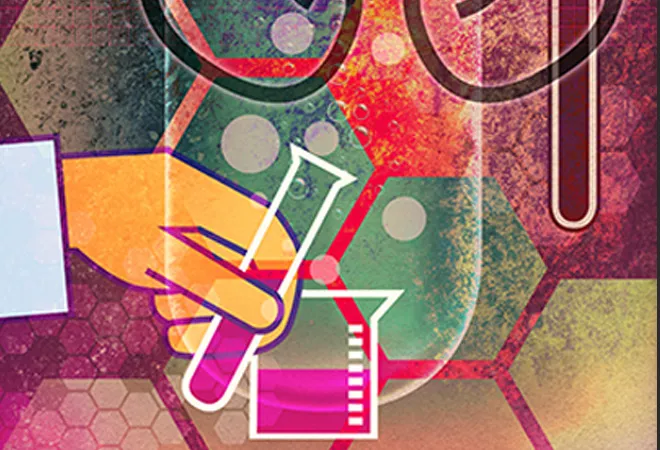
If the COVID crisis has exposed the fragility of our global supply chains, it has also exposed us to the need to develop effective models of interdependence. The current pandemic has uncovered the limitations to the pharma sector’s business model, and has forced companies to address the urgency needed to develop a new model of drug discovery and development, needed for pandemics and neglected diseases. Investments in
pandemic preparedness and neglected diseases like tuberculosis, malaria has never been a priority for pharmaceutical drug development, even though annual mortality in these neglected diseases are in the millions. COVID has taught us that there is an urgent need for convergence in the life sciences sector (where R&D, startups, biotech, pharma, digital platforms) all need to come under one umbrella for efficient delivery and effective responsiveness. We need investments in innovations and discover new ways of engaging. An integrated way of working together which involves sharing of skills, resources, infrastructure, and exclusive knowledge.
Can a post-COVID Australia-India partnership be driven by innovation and research that is integrated and opens pathways to build health and wellbeing?
A lesson that all of us have learnt in this crisis, is that drug discovery, clinical trials, launching critical therapies all takes time and is a long-drawn-out process. Fighting a pandemic
asks for quicker processes. Hence, it is imperative to identify partnerships with countries that can be effective collaborators in this journey with their respective strengths. Can a post-COVID Australia-India partnership be driven by innovation and research that is integrated and opens pathways to build health and wellbeing?
Identifying synergies in life sciences
India today, is widely called the ‘pharmacy of the world’ with its strong domestic presence and strong global exports. It was also a trusted supplier of critical pharmaceuticals (eg. export of Hydroxychloroquine) to over 120 nations in the recent COVID crisis. India’s pharmaceutical strength can be understood from the huge presence of over 3,000 pharma companies, with over 10,000 manufacturing facilities. India is the source of 60,000 generic brands across 60 therapeutic categories. With its low cost of manufacturing (33% lower than that of the US), India caters to the need of over 50% of the global demand for vaccines.
40% of generic drugs in the US and over 25% of all the medicines in the UK are exported from India. India ranks 3rd worldwide for production by volume and 13th by value. Out of the top 20 global generic companies, eight are from India. Indian government has also announced a US$ 394 million scheme to promote the development of three industrial parks focused on the manufacturing of
APIs and bulk drugs.
India was a trusted supplier of critical pharmaceuticals (eg. export of Hydroxychloroquine) to over 120 nations in the recent COVID crisis.
On the other side, ‘Australia is a leader in R&D in biotech. The 2016 Scientific American Scorecard placed Australia at #5 globally in an assessment of innovation potential in biotech. Australia is also in the top 10 most competitive locations for R&D development.’ The
Australian biotech sector has attracted great interest from pharmaceutical companies around the world wanting to invest. Beyond Bio-pharma which constitutes 69% of the Australian biotech sector, Australia also has a strong biotech potential and making its presence felt globally in marine biotechnology, dairy biotechnology, environmental, sustainable water use, agricultural and industrial biotechnology.
The life sciences sector is a sector of strategic priority for Australia. Its competitive and path breaking research in segments like oncology, ophthalmology, infectious diseases, vaccines, respiratory, neurology, and regenerative medicine offers tremendous opportunities for India to build meaningful collaborations. For Australia, challenges lie in commercialisation, cost effective market access, and its heavily import dependent medical supply chain. Australia imports
over 90% of medicines and is at the end of a very long global supply chain, making the nation vulnerable to supply chain disruptions. Can there be opportunities for building strategic alliances between
Australia and India?
Australia also has a strong biotech potential and making its presence felt globally in marine biotechnology, dairy biotechnology, environmental, sustainable water use, agricultural and industrial biotechnology.
• Australia and India can work together on the launch of new chemical entities, complex generics, drug discovery, translational research, community health delivery and incremental innovation of R&D products.
• India offers, cost effective opportunity for commercialisation and scaling up of technology, supplemented by its large and diverse demographic profile, which could offer cheaper and time efficient drug recruitment and clinical trials.
• Both countries can work together on drug repurposing (drug repositioning), a strategy that enables reuse of existing licensed drugs for new medical symptoms, and can effectively reduce drug development time, the pre-clinical trial phase time and substantially reduce costs.
• Both countries can together identify new vaccine candidates in infectious diseases (like Tuberculosis), focus on non-communicable and life style diseases, critical therapies, and animal therapeutic products.
• The IP based Australian economy can amplify and accelerate India’s growing bioresearch services, which is the second largest growing sector after Biopharma. India’s bio-economy is constantly going up (US$ 63 billion), with a target of becoming US$ 100 billion by 2025.
• India offers low cost to innovation and the risk of failure is low, as it offers cost arbitrage to value arbitrage. Australian companies can do more innovation in India, supported by its strong IP framework — India’s market offers opportunities in co-creating and global scale production. Large Australian companies like CSL (which is leading in innovative biotherapies), leading animal healthcare companies have no presence in India currently.
• Australia’s unique pro-substitution approach to biosimilars is a learning opportunity (which means ‘encouraging prescribing of biosimilars rather than the reference biologic to patients receiving treatment for the first time, also allowing a pro-substitution approach, for example allowing the “a-flagging” of anti-TNF biosimilars. A-flagged biosimilars can be substituted by pharmacists at the point of dispensing without permission from the prescribing clinician. No other regulator currently allows substitution of biosimilars at pharmacy level).
• Australia’s Therapeutic Goods Administration (TGA), regulatory authority for therapeutic goods such as medicines, medical devices, and diagnostic tests is a transparent and robust clinical validation process. India can learn from this, as it evolves its own functioning model.
• Under the New Education Policy, Australia can support India in building its life science workforce. Through its pharmacy education and skill development (short-term PG technical courses in medical specialties, technical short courses and online modules), National Institute of Pharmaceutical Education and Research (NIPER) is a great foundation for building the life science sector. India can also explore Australia’s expertise in healthcare delivery to remote areas, data analytics techniques to predict future demand for health.
• Indian institutions can learn from Australia’s research ecosystem, which has witnessed strong life science acceleration in the academic system, followed by vibrant spinouts, facilitated by university-industry partnerships.
• Australia and India can together identify top ten research areas (virology, epidemiology, neurosciences, stem cell research etc.). Government grants supported by industry should be provided to establish quality output.
Addressing barriers — Australia and India
Affordability, accessibility and quality are at the very core of India’s life sciences vision. What is required is:
• A deep awareness and recognition of each other’s strengths.
• Creating sustainable institutional channels of engagement (joint working group in the life science sector). There is a strong need to connect all stakeholders (government — academicians — industry) and have their say in policy regulations.
• Creating innovative breakthrough models of engagement that goes beyond the traditional life sciences industry, and is embracing new business models driven by digital technology and artificial intelligence.
• Identify ways where there could be greater alignment between science and business. Australian superfunds with its investment interests in India, could consider allocating 2-3% of risk funds for driving collaborative life science innovation.
Going forward, collaboration and commercialisation of research should be a key benchmark of Australia and India’s life sciences partnership.
The views expressed above belong to the author(s). ORF research and analyses now available on Telegram! Click here to access our curated content — blogs, longforms and interviews.



 If the COVID crisis has exposed the fragility of our global supply chains, it has also exposed us to the need to develop effective models of interdependence. The current pandemic has uncovered the limitations to the pharma sector’s business model, and has forced companies to address the urgency needed to develop a new model of drug discovery and development, needed for pandemics and neglected diseases. Investments in
If the COVID crisis has exposed the fragility of our global supply chains, it has also exposed us to the need to develop effective models of interdependence. The current pandemic has uncovered the limitations to the pharma sector’s business model, and has forced companies to address the urgency needed to develop a new model of drug discovery and development, needed for pandemics and neglected diseases. Investments in  PREV
PREV


